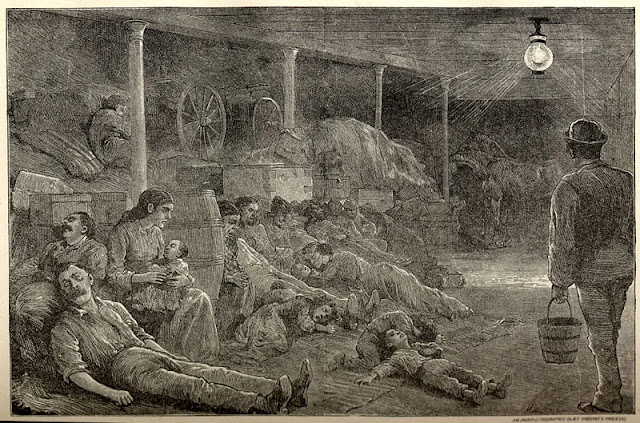 |
A pandemic is an epidemic of an infectious
disease that has spread across a large
region, for instance multiple continents or worldwide, affecting a substantial number of people. A
widespread endemic disease with
a stable number of infected people is not a pandemic. Widespread endemic
diseases with a stable number of infected people such as recurrences of seasonal
influenza are generally excluded as they
occur simultaneously in large regions of the globe rather than being spread
worldwide.
Antonine Plague (165-180 A.D.)
Deaths: 5 Million
Sources: Smallpox or Measles
The Antonine Plague of 165 to 180 AD, also known as the Plague of Galen (after Galen, the physician who described it), was an ancient pandemic brought to the Roman Empire by troops who were returning from campaigns in the Near East.
Scholars have suspected it to have been
either smallpox or The plague may have claimed the life of
a roman Emperor, Lucius Verus, who died in 169 and was the co-regent of Marcus
Aurelius Antoninus, whose family name, Antoninus, has become associated with
the pandemic.
Plague of Justinian (541-549 A.D.)
Deaths: 25-30 Million
Sources: Rates and Fleas
The Plague of Justinian or Justinianic Plague (541–549 AD) was the beginning of the first plague pandemic, the first Old World pandemic of plague, the contagious disease caused by the bacterium Yersinia pestis.
The disease afflicted the entire Mediterranean Basin, Europe, and the Near East, severely affecting the Sasanian Empire and the Roman Empire and especially its capital, Constantinople. The plague is named for the Roman emperor in Constantinople, Justinian I (r. 527–565), who according to his court historian Procopius contracted the disease and recovered in 542, at the height of the epidemic which killed about a fifth of the population in the imperial capital.
The contagion arrived in Roman Egypt in 541 and
spread around the Mediterranean Sea until
544; in Northern Europe and
the Arabian Peninsula it
persisted until 549.
Black Death (1347-1359)
Death: 75-200 Million
Source: Rates and Fleas
The Black Death (also known as the Pestilence, the Great Mortality, or the Plague) was the deadliest pandemic recorded in human history. The Black Death resulted in the deaths of up to 75–200 million people in Eurasia and North Africa, peaking in Europe from 1347 to 1351.
Plague, the disease caused by the bacterium Yersinia pestis, was the cause; Y. pestis infection most commonly results in bubonic plague, but can cause septicaemic or pneumonic plagues. The Black Death was the beginning of the second plague pandemic.
The plague created religious, social, and economic
upheavals, with profound effects on the course of European history.
New World Smallpox (1520-Unknown)
Death: 25-55 Million
Cause: Variola Virus
Smallpox was an unknown disease not only in Mexico, but in all the Americas, before the arrival of Europeans. It was introduced to Mexican lands by the Spanish and played a significant role in the downfall of the Aztec Empire.
Hernán Cortés departed from Cuba and arrived in Mexico in 1519, sent to start trade relations only on the Veracruz Coast. However, he disobeyed the Cuban governor and began to invade the mainland. The governor sent Pánfilo de Narváez after Cortés.
Narvaez’s forces had at least one active
case of smallpox, and when the Narvaez expedition stopped at Cozumel and Veracruz in
1520, the disease gained a foothold in the region.
Great Plague of London (1665-1666)
Deaths: 70,000-100,000
Source: Rats and Fleas
The Great Plague, lasting from 1665 to 1666, was the last major epidemic of the bubonic plague to occur in England. It happened within the centuries-long Second Pandemic, a period of intermittent bubonic plague epidemics which originated from Central Asia in 1331, the first year of the Black Death, an outbreak which included other forms such as pneumonic plague, and lasted until 1750.
The Great Plague killed an estimated 100,000 people—almost a quarter of London's population—in 18 months. The plague was caused by the Yersinia pestis bacterium, which is usually transmitted through the bite of an infected rat flea.
The 1665–66 epidemic was on a far smaller scale than
the earlier Black Death pandemic; it was remembered afterwards as the
"great" plague mainly because it was the last widespread outbreak of
bubonic plague in England during the 400-year Second Pandemic.
The Cholera Pandemics (1817-1923)
Deaths: 1 Million
Cause: V. Cholerae Bacteria
Few societies have been spared by this highly infectious bacteria, which is transmitted via feces-contaminated water and causes severe diarrhea and vomiting.
The epidemic that swept London in 1854 spawned the sort of epidemiological investigations that take place in disease outbreaks today. That’s thanks to John Snow, an English physician who almost single-handedly took on the bacteria. While some scientists suspected cholera was transmitted through the air, Snow thought otherwise.
“Through carefully mapping the outbreak, he finds that
everyone affected has a single connection in common: they have all retrieved
water from the local Broad Street pump,” according to a CDC history. He ordered
the pump-handle turned off, and people stopped getting sick.
Yellow Fever (Late 1800s)
Deaths: 150,000
Causes: Yellow Fever Virus
Vector: Mosquito
The Yellow Fever Epidemic of 1793 struck during the summer in Philadelphia, Pennsylvania, where the highest fatalities in the United States were recorded. The disease probably was brought by refugees and mosquitoes on ships from Saint-Domingue.
It rapidly spread in the port city, in the crowded blocks along the Delaware River. About 5000 people died, ten percent of the population of 50,000. The city was then the national capital, and the national government left the city, including President George Washington.
Philadelphia, Baltimore and New York
suffered repeated epidemics in the 18th and 19th centuries, as did other cities
along the East and Gulf coasts.
Spanish Flu (1918-1920)
Deaths: 50-100 Million
Cause: H1N1
The Spanish flu, also known as the 1918 flu pandemic, was an unusually deadly influenza pandemic caused by the H1N1 influenza a virus.
Lasting from February 1918 to April 1920, it infected 500 million people–about a third of the world's population at the time–in four successive waves.
The death toll is typically estimated to have been somewhere between 17 million and 50 million, making it one of the deadliest pandemics in human history.
Asian Flu (1957-1958)
Deaths: 1 Million
Cause: H2N2
The 1957–1958 influenza pandemic, also known as the Asian flu, was a global pandemic of influenza a virus subtype H2N2 that originated in Guizhou, China, and killed at least a million people worldwide.
The first cases were reported in Guizhou in late 1956 or early 1957, and they were reported in the neighbouring province of Yunnan before the end of February. On 17 April, The Times reported that "an influenza epidemic has affected thousands of Hong Kong residents". By the end of the month, Singapore also experienced an outbreak of the new flu, which peaked in mid-May with 680 deaths.
In Taiwan, 100,000 were affected by
mid-May, and India suffered a million cases by June. In late June,
the pandemic reached the United Kingdom.
Swine Flu (2009)
Deaths: 300,000
Cause: H1V1
The 2009 swine flu pandemic was an influenza pandemic that lasted for about 19 months, from January 2009 to August 2010, and was the second of two pandemics involving H1N1 influenza virus (the first being the 1918–1920 Spanish flu pandemic).
First described in April 2009, the virus appeared to be a new strain of H1N1, which resulted from a previous triple reassortment of bird, swine, and human flu viruses further combined with a Eurasian pig flu virus, leading to the term "swine flu".













1 Comments
If you have any doubt, comment below
ReplyDelete